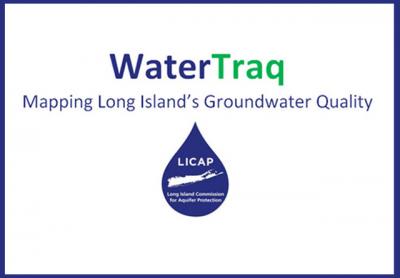Website a Window on Water Quality

Information about the state of Long Island’s groundwater and on the quality of the treated drinking water provided to residents by various suppliers, including the Suffolk County Water Authority, can be found on WaterTraq, a new interactive website developed by the Long Island Commission for Aquifer Protection.
The website was a highlight last week of a talk at the East Hampton Library by representatives of the water authority, the first in a series of “WaterTalk” sessions that will focus on groundwater quality and conservation, and give the public a chance to ask experts about issues of concern.
The water authority’s chief executive officer, Jeffrey W. Szabo; its lead hydrogeologist and director of strategic initiatives, Ty Fuller; its laboratory manager, Tom Schneider, and its workforce technology manager, Larry Anderson, were on hand for the discussion.
On the WaterTraq site, visitors can click on a map to see data about the water in a particular area, or search for information by putting in an address. In addition, one can check to see whether certain chemicals or compounds — among those that the public water supplier tests for — are present in the water.
The county takes samples from its wells weekly, monthly, or quarterly, Mr. Schneider said, and tests them for more than 400 compounds, both naturally occurring or man-made pollutants. They include pesticides, herbicides, pharmaceuticals, and the active ingredients in household products.
The level of scrutiny exceeds that mandated by New York State, he said, which requires testing water for the presence of 150 compounds.
Should pollutants be found, the water is treated so that it falls within, or exceeds, state and federal drinking water standards.
“There is a big difference between what’s in the groundwater and what’s finished and treated and provided to you” by the S.C.W.A. for drinking water, Mr. Fuller stressed.
Besides the new WaterTraq online system, the water authority posts on its own website annual water quality reports covering five years. Its system has a number of distinct “pressure zones,” Mr. Schneider said, from which water is pumped, and they do not generally intermix. “Your water is coming from within about two miles of your house,” he said.
There are about 25 S.C.W.A. wells in East Hampton Town. The water is treated for contaminants with the use of granular-activated carbon filters, and also treated with chlorine and with lime, to maintain a balanced pH level. Groundwater on Long Island is naturally acidic, Mr. Fuller said, and iron in it, which can result in pinhole leaks in pipes, is often a concern.
Many people in East Hampton living outside areas in which county water mains have been extended get water from their own private wells. Mains can be extended once a certain percentage of neighborhood residents agree to sign on. The “tapping fee” for hooking up to a water main is $1,650 at present, the S.C.W.A. representatives said, bringing the overall individual cost here, with other fees, of obtaining “public water” to about $7,000. That can be paid over time, and the speakers said that state funds earmarked for clean water initiatives may also be authorized to offset the cost.
What does the water authority do regarding notification of neighbors with private wells when contaminants are found in tested groundwater, someone asked.
“The water quality could be quite different” in neighboring wells, Mr. Schneider said, explaining that the authority’s wells are much deeper than the typical private well. But, he said, when alarming water test results are found in the lab, they are shared with the water authority staff, and if the source of pollution is clear, action is taken.
For instance, said Mr. Fuller, when methyl tertiary butyl ether, or M.T.B.E., a gasoline additive, was detected in Long Island water, the authority pursued legal action against its manufacturers, and its efforts resulted in state legislation establishing, for the first time, a standard for the compound in drinking water.
“We’re very concerned about saltwater intrusion,” said Mr. Schneider in answer to a question about how the authority might be taking sea level rise, and increased development and demand for water, into account. There is a 10-year plan, he said, to address the issue of protecting wells in coastal communities from saltwater intrusion.
Water conservation is a key element, the spokesmen said. While an average customer uses about 160,000 gallons a year, the largest users on the East End consume 22 million gallons annually. Much of the water used by all customers is for irrigation.
Tips provided to conserve water include watering the garden only on odd or even days, running sprinkler systems at night, outside peak demand hours, reducing shower time by five minutes, which can save 1,000 gallons of water per month, fixing leaky faucets (one drip per second wastes 1,661 gallons a year), and using faucet aerators and low-flow showerheads and faucets.
A discussion of an adjusted rate schedule for those who use greater amounts of water will take place later this year.
Meter reading is now done using advanced wireless technology that allows data to be collected from meters simply by driving past a residence.
Through an entertaining short film and a talk by Mr. Anderson, those at last week’s meeting were informed about the history of meter reading and how practices and technology have changed since the early 1900s.
